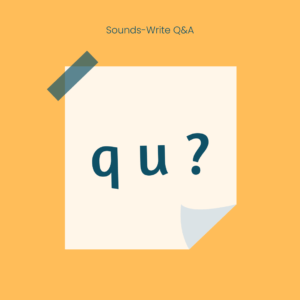
On our training and on our Facebook page for educational professionals who have already trained, I am asked all the time about the spellings < q > and < u > in words like ‘quick’, ‘quit’, and ‘squid’.
The problem arises because < q > and < u > co-occur so frequently in English and because in many other phonics programmes the two are taught as one unit and, even by many teachers, as one sound.
We acquired the spellings < q > and < u > from French sometime after the Norman invasion, but prior to that, we spelt the sounds /k/ and /w/ in, for instance, ‘queen’ as < c > and < w >. No confusion there.
If we are teaching a sound-to-print approach, we teach separate sounds separately, whether they co-occur frequently or not.
If teachers teach the two sounds in any way other than separately, students are going to come across the spelling < q >, representing the sound /k/ in some words, such as ‘Iraq’ and ‘Qatar’. In addition, they’ll also notice that advertisers like to play around with < q > as a spelling of /k/ for the purpose of attracting attention to their products. Qinetiq is an aerospace engineering company and then there’s the Skoda Karoq, for example.
Later, as learning progresses, the spelling < u > will occur in words such as ‘persUade’ and ‘extingUish’, where it represents the sound /w/.
Like < c >, < k > and < ck >, < q > is a spelling alternative for /k/; and like < w > and < wh >, < u > is a spelling alternative for /w/. At the end of the Initial Code and just before we start teaching the Extended Code, teaching < q > and < u > as separate spellings of the sounds /k and /w/ is good practice and will help deepen children’s understanding that we can spell sounds in more than one way.